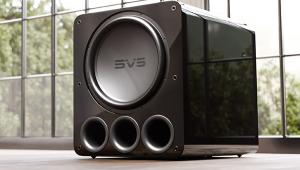Resource Center: Surround Sound Page 5
Bass Management All A/V receivers and surround processors provide bass management, which is a system for routing low frequencies to speakers according to their ability to handle deep bass. This is necessary for home theater systems because movie soundtracks often contain extremely intense low-frequency energy that could easily damage the relatively small woofers commonly used in surround and center-channel speakers. (Note that bass management won't ensure that speakers are never overdriven - it just minimizes the probability.) It is possible because human beings can't easily determine where sounds below about 100 Hz are coming from. So, to take a peculiar example, you could send the bass for all channels to the right front speaker and not be able to tell by ear that anything unusual was going on.
The procedure is straightforward: When you install your system, you go to your receiver's speaker-setup menu. There you indicate whether or not the system includes a subwoofer and whether each speaker is "large" or "small." If the system has a subwoofer, it receives the signal from the LFE (low-frequency effects) channel in 5.1-channel soundtracks and the low bass from all channels connected to speakers designated as small. If the system does not have a subwoofer, the LFE and bass from channels designated as small are distributed evenly to the speakers designated as large. Either way, speakers configured as large receive complete, full-range outputs from the channels to which they are connected.
As should be clear from the above, it is important to judge carefully whether a speaker should be designated as large or small. Generally speaking, you should consider any speaker that cannot produce strong bass down to 40 or 50 Hz to be small, regardless of its physical size. And in a system that has a good subwoofer, it often is best to configure all the main speakers as small, even if some of them are capable of extended bass response. This allows the main speakers to be placed where they need to be for proper imaging and surround sound, pretty much without regard for how this affects their low-frequency performance. The subwoofer, on the other hand, can be located for optimal bass performance.
Another thing worth noting is that bass management breaks the familiar one-to-one relationship between signal channels and speakers. This is a common point of confusion with, for example, 5.1-channel soundtracks, where people often assume that the ".1" LFE channel is a "subwoofer channel," which isn't really the case. A 5.1-channel soundtrack contains five full-range channels and a bass-only low-frequency effects channel. A 5.1-channel playback system, on the other hand, contains five speakers, some or all of which may not be full-range, and a subwoofer. It is possible, if all five main speakers in such a system are full-range, to maintain perfect correspondence between soundtrack channels and reproduction channels, but this is very rare in home theaters. Normally bass management gets into the act to redirect the soundtrack's low-frequency content according to the specific capabilities of the system's speakers.
THX what can THX do to improve your home theater?
Setup Whether you're immersing yourself in surround sound for the first time or just want to fine-tune your system, we show you how to set up your speakers and receiver. Perplexed by mysterious jacks on your A/V gear? Our comprehensive guide will help you hook it all up.
Back to Surround Sound Overview | Back to Resource Center Home
- Log in or register to post comments














































